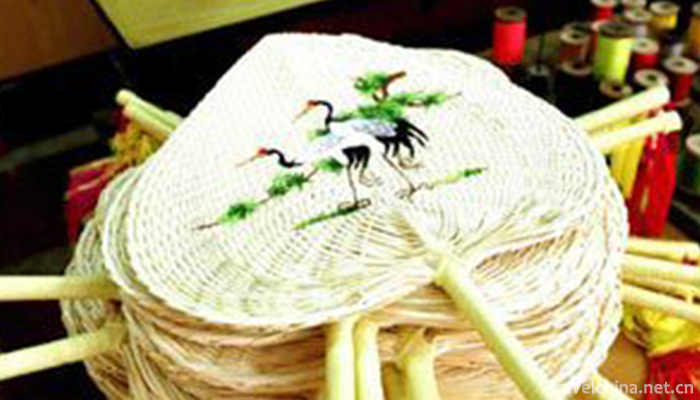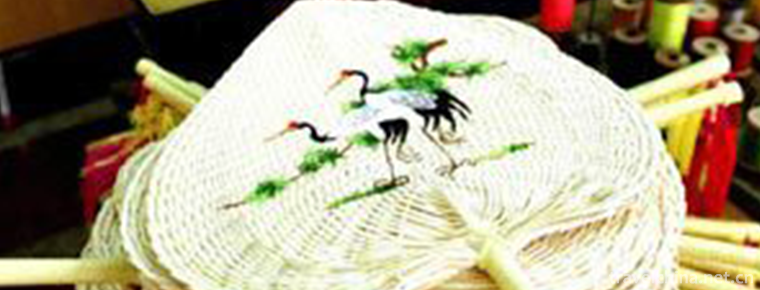Xinhui Sunflower Art
Xinhui Sunflower Art
Xinhui Sunflower Art, a traditional Chinese handicraft, originated in Xinhui District, Jiangmen City, Guangdong Province. Xinhui Sunflower Art has a history of more than 1600 years, and became famous internationally as early as the beginning of the 20th century. In 1915, Xinhui Bamboo Choice Sunflower Fan won the gold medal of Panama Expo. In 1988, Liao Huilin, then director of Xinhui Sunflower Artistic Products Factory, went abroad to participate in the Paris French Communist Festival to perform live Sunflower Artistic performances.
On June 7, 2008, Xinhui Kuiyi was listed in the second batch of national intangible cultural heritage list with the approval of the State Council.
Xinhui Sunflower Art is famous all over the world because it has superb plastic arts and exquisite knitting skills, and combines knitting, embroidery, painting, printing and other techniques in one furnace.
historical origin
Xinhui sunflower artwork is a well-known traditional Chinese handicraft. According to the Record of Xinhui County, during the Eastern Jin Dynasty 1600 years ago, Xinhui began to plant sunflower trees and process sunflower artwork. In the Qing Dynasty, Xinhui sunflower fans were sold well all over the country, and also exported to 24 countries and regions, such as Russia, Britain, the United States, France, Cuba, Colombia, Peru and Chile. At the end of the Qing Dynasty and the beginning of the Republic of China, the sales volume of Xinhui sunflower fans reached 120 million units per year.
As early as the early 20th century, Xinhui Sunflower Art became famous internationally. In 1915, Xinhui Bamboo Choice Sunflower Fan won the gold medal of Panama Expo. From July 1 to 7, 1958, Premier Zhou Enlai personally visited the New Society for in-depth investigation and inspection. During the week of the New Conference, Premier Zhou Enlai also visited the Sunflower Art Factory of Xinhui in a dusty manner. During his visit to the Sunflower Art Factory, he also kindly fanned sunflower artists, and the phrase "I am not a fan" still widely circulated in the New Conference. Come to work in the New Society, but come here to learn.
In the 1960s and 1970s, Xinhui Sunflower Art also created the economic value of "one step, three yuan". In 1975, the highest planting area was 30,000 mu, with an annual output of about 100 million sunflower fans, which became the pillar industry of Xinhui.
Production process
The process of making sunflower art is very complicated and meticulous. Generally speaking, from picking sunflower to making handicraft products, there are nearly 20 processes, such as cutting, drying, baking, cutting, bleaching, dyeing, knitting, crocheting or inlaying, printing and embroidery. It takes more than 10 people to make a sunflower artwork. From this, we can see that the art of Xinhui Sunflower is very precious.
Product Classification
Before liberation, due to the backward production technology and the domination of the gang feudal forces, the processing technology was conservative, the development of fancy varieties was slow, and the products were relatively single. Sunflower fans were mainly produced in the whole industry, and sunflower bones and awnings were also produced as by-products of three varieties. After thousands of years, it still stays in the mode of production of manual workshops. Under such backward production conditions, Xinhui Sunflower Workers still rely on hard work and wisdom to create a large number of exquisite handmade sunflower products.
After liberation, the craftsmen of Sunflower Art Factory carried out systematic research and trial production. In addition to inheriting the traditional crafts production, they constantly created new products. By the 1980s, there were more than 500 varieties of Sunflower Art products in Xinhui, which could be divided into three categories: sunflower fans, crafts and sunflower by-products.
Sunflower Fans
It refers to the fan made from sunflower leaves by cutting, sun drying, baking, baking, knitting and sewing. There are more than one hundred kinds of fans, such as cattle heart fan, chicken heart fan, glass fan, fire painting fan, bleaching embroidery fan, bamboo seal painting fan and glue weaving fan. According to the size of the model, it can be divided into large fan, medium fan, young fan and small fan. According to the quality of raw materials or manufactured sunflower fans, it can be divided into 1 to 4 grades.
Xinhui Sunflower Fan has always been famous for its round core, fine bone, white, flexible and smooth surface, and excellent knitting technology. Especially bamboo sheath painting fan, its processing needs four processes: knitting, drawing, portraying and sticking, all of which are meticulous work, and photolithography takes several days. This precious bamboo sheath painting fan used to be gifts and appreciation gifts given to each other by dignitaries and dignitaries. In 1915, he participated in the Panama Expo and won the honorary gold medal.
Fire Painting Fan
It is a kind of craft product with high requirement of painting technology in glass fan. It is said that the fire painting fan originated in the late Tongzhi period of the Qing Dynasty. At that time, the style of poetry, calligraphy and painting was more flourishing. Chen Yan, a famous painter in the New Society, cut and paste poetry and painting on glass fans, but it was not firm and would fall off when damped. It also developed the use of ink or pigments to draw poems directly on fans, but also easy to fade. Later, the poems and paintings painted on fans were burned with incense to show the poems and paintings. By the thirteenth year of Tongzhi (1874), he began to use iron pens to burn red in the fire, and then branded poems and paintings on the fan. Around 1914, when Liu Yiji Fanliao processed the spark fan, the technology developed. The method was to select two thin glass fans, first to cut off the backbone and handle of the fan, and then to synthesize a double-sided fan. In this way, both sides of the fan can be painted with a fountain pen. The edges of the fans were sewn with colored velvet and gradually developed into three-ridge and five-ridge fire painting fans with elegant style and elegant appearance. Fan handle also has a variety of decorations, useful bamboo. There are brown bamboo, Buddha belly bamboo, mottled bamboo and hedgerow bamboo. There are also ivory or rattan stalks. Film clips and sharp corners are used as nails. Among them, the ivory fire painting fan, with gorgeous decoration and noble value, is a fine collection of fans. Rich families use it as gifts for each other, and its products are well-known both at home and abroad.
Sunflower Basket
It is made from sunflower, sunflower leaf or sunflower vine by cutting, winding, weaving angle, trimming, claw ear, crochet or inlay, printing and other knitting processes. Sunflower basket has strong practicability and high ornamental. Some are shaped like backpacks, some are shaped like waistpacks, some are shaped like pots, some are shaped like pagodas, some are shaped like Palace lamps, lifelike, smooth lines, rich and colorful, exquisite craftsmanship, ingenious craftsmen.
Crafts
Including sunflower basket, sunflower hat, sunflower mat, sunflower mat, sunflower mat pillow mat, sunflower mat, car seat mat, sunflower curtain, sunflower mat, sunflower mat, sunflower disc, etc. And these products have many fancy varieties. There are nearly 300 flower varieties in sunflower baskets alone. Handicraft products are generally divided into 1 to 3 grades and inferior products according to the quality of manufactured products.
Sunflower by-products
Refers to sunflower products made from scrap material after cutting sunflower fans. Including sunflower claw tail, sunflower tie, sunflower bone, sunflower bone broom, sunflower bone hand sweep, sunflower stalk rattan, sunflower canopy, sunflower brown broom, sunflower cow rope, and so on.
Sunflower Sofa Cushion
It is made of sunflower rattan by bleaching, dyeing and knitting. With pure and white sunflower rattan, cleverly weave into four-sided continuous, up-down, left-right, symmetrical rhombic pattern, diagonally connected rhombic pattern, appears regular and rhythmic; black and yellow pattern contrast is strong, highlighting the large area of pure and white sunflower rattan, the whole cushion color. The combination of black, yellow and white patterns, the transition and contrast of the three colors, make the rhombic patterns of repeated arrangement change and form several geometric patterns subtly, thus producing a beautiful decorative rhythm. It also uses "plum flower horn" pattern as the decorative edge, which adds the decorative beauty of cushion.
Inheritance Significance
With the development of the times, sunflower products are gradually replaced by industrial products, and the demand and sales of sunflower products are declining. Local people had hoped that Sunflower Art could be transformed into handicraft so that Sunflower Art could be continued. However, affected by market economy and social development, this road has become more and more difficult: sunflower planting area is decreasing year by year, Sunflower Art talents are becoming scarce, and Sunflower Art in Xinhui is increasingly facing the crisis of disappearance.


-
1.Pork ribs Noodles
Pork ribs Noodles are a traditional pasta, especially in Cantonese cuisine
Time 2018-10-12 -
2.PRC Cradle Scenic
Cradle Scenic Area of Ruijin Republic, National AAAAA Tourist Scenic Area, National Key Cultural Relics Protection Unit, National Patriotic Education Demonstration Base, National Red Tourism Classic S
Time 2018-12-08 -
3.Rolling lamp
Rolling lantern is an art form of entertainment and self-enjoyment for the masses in Han folk festivals, and also a competitive performance to show the strength of villages. It is mainly prevalent in
Time 2019-05-02 -
4.Eastern Mongolian Folk Stories in Kazuo
The Folktales of Kazuo East Mongolia are spread in an oral literature in the left-wing Mongolian Autonomous County of Karaqin. Folk narrators, in the traditional way of oral narration and singing,
Time 2019-05-08 -
5.Throw stones Lock
Throw stones Lock is an ancient martial arts skill item, which originated in the Tang and Song Dynasties. It has been widely circulated among the Hui people in Kaifeng for a long time. During the Qing
Time 2019-05-13 -
6.Pangu Myth
Pangu myth, the local traditional folk literature of Tongbai County and Biyang County in Henan Province, is one of the national intangible cultural heritage.
Time 2019-06-08 -
7.Lead tin carving
Lead and tin carving, a local traditional skill in Jingzhou City, Hubei Province, is one of the national intangible cultural heritage.
Time 2019-06-10 -
8.Shengzhou Blows
Shengzhou blowing is one of the main components of "gong and drum in eastern Zhejiang". "Zhedong Gong and drum" generally refers to the traditional folk instrumental music in easte
Time 2019-06-14 -
9.Yao Opera
Yao Opera is popular in Yuyao, Cixi, Ningbo, Zhoushan, Shangyu and Shaoxing. It developed on the basis of folk singing and dancing "horse lantern", "dry boat" and "tea basket&
Time 2019-07-11 -
10.Chinese history
Chinese history From China Chinese civilization To the present history. China has a long history. Since the Huangdi tribe Ji Xuanyuan (also known as the Gong sun Xuanyuan) period has been counted for
Time 2019-08-28 -
11.Sichuan Tourism University
Sichuan Tourism College is the first independent tourism undergraduate college in China. In 2018, it was approved by the Overseas Chinese Office of the State Council as the base of "Overseas Chin
Time 2019-08-31 -
12.Main scenic spots in Meishan
Jiulongshan Forest Park is located in the southwest of Sichuan Province, in Yangchang Town, Danling County, Meishan City, about 20km away from Danling county. It covers an area of 380 hectares, including 100 hectares of core scenic area. The a
Time 2020-12-18